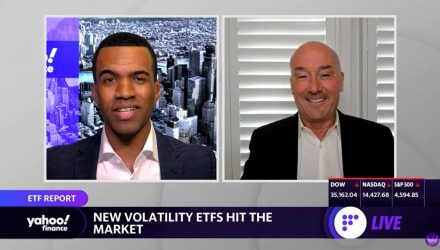On this week’s “ETF Report” hosted on Yahoo Finance, ETF Trends’ CEO, Tom Lydon, came into the segment to discuss the effect Russia’s invasion of Ukraine has had, specifically in regards to the fear gauge index (VIX), which has retreated, as well as a couple of new volatility ETFs.
As far as why the VIX is retreating amid unresolved matters on the broader international conflict side, Lydon has some thoughts on what is going on. Perhaps there are talks taking place, the Fed may not be so hawkish, or it could come down to stability in the marketplace, as growth stocks have come back a bit in the past week.
Looking at somewhat positive aspects, a week ago, the VIX was up around 40. Now it’s hovering around 20. It’s positive for the market but not always an indicator of what may be coming in the near future.
Looking at some ETFs that allow those who so desire to invest in the VIX, two new funds let investors place bets on stock market gyrations are expected to launch this week, potentially filling the void left by the implosion of similar products four years ago.
The 1x Short VIX Futures ETF (SVIX) and the 2x Long VIX Futures ETF (UVIX) have received regulatory approval to list and will start trading on Wednesday, said Stuart Barton, chief investment officer at Volatility Shares, the company releasing the ETFs.
The new fund’s daily valuation will be calculated from the average futures prices over the last 15 minutes of the trading day, rather than just the futures settlement price, as in the case of XIV. In theory, that would reduce the funds’ vulnerability to sophisticated investors anticipating how its rebalancing could impact futures prices, according to analysts.
.@ETFtrends CEO @TomLydon on the new VIX ETFs hitting the market: “You have to understand what you’re buying.” Full comments: pic.twitter.com/5pgdiekD6D
— Yahoo Finance (@YahooFinance) March 30, 2022
Additionally, Morgan Stanley is now entering the ETF space. For Lydon, there’s the feeling that it just keeps getting better when seeing big companies like this getting involved. Having hired some industry veteran experts to help out with this move, their huge distribution is clearly going to be matched with this attempt to contend with what’s been challenging their mutual funds.
Lydon adds, “There are more choices than ever. If you’re an individual investor and not trading, you’re just trying to do asset allocation. There’s plenty for you. At the same time, there are a lot of traders out there, whether you’re an institution or an advisor, or a self-directed investor, there are all different shapes and sizes. However, more than ever, you have to understand what you’re buying.”
He moves out to point out how, earlier this week, the Financial Industry Regulatory Authority Inc. (FINRA) released a regulatory notice that included a request for public comment regarding oversight of leveraged and inverse exchange-traded products, options, and other complex investments in an environment where investors can buy them on trading apps and over the internet.
Lydon explains how this is not something that’s wanted. “You want the freedom to be able to buy and sell and leave it up to investors to do their homework. However, there is concern that some people may shoot themselves in the foot. From our standpoint, there are a lot of other investments out there as opposed to ETFs, so it will be interesting to see how this comes out.”
For more market trends, visit ETF Trends.
